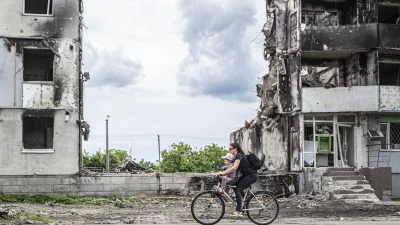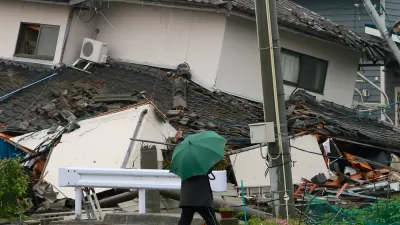Christopher Hawthorne reports from Japan on the many obstacles preventing areas destroyed by the Tōhoku earthquake and tsunami from proceeding with rebuilding, as the recovery effort stalls in the cleanup stage.
Although northeastern Japan has made enormous strides in removing the astonishing amount of debris caused by last year's disaster, Hawthorne outlines the leadership and political roadblocks that have prevented communities from starting in earnest on substantial construction efforts, as some of the largest questions regarding rebuilding go unanswered.
According to Hawthorne, "Prime Minister Yoshihiko Noda, his approval rating in danger of sinking below 30%, has faced wide criticism for failing to articulate a broad vision for rebuilding. The national Reconstruction Agency wasn't officially launched until February, 11 months after the disaster...The most intractable issue is whether the hardest hit fishing villages, already losing population before the disaster, should be rebuilt as they were or consolidated." Larger socio-economic fault lines have also been exposed by the earthquake, and these issues must be discussed as they are likely to guide rebuilding plans.
The lack of progress on rebuilding is not for lack of trying by the country's architects and planners who have worked diligently with local communities to develop plans for reconstruction.
While a larger vision for recovery goes unarticulated, local communities have also struggled to develop consensus on how to rebuild their towns. "Sharp disagreement" amongst local residents and politicians "over reconstruction goals has repeated itself in the smaller towns along the Oshika Peninsula," according to Hawthorne. And "the lack of consensus on basic issues calls into question precisely how" $3.75 billion in rebuilding grants recently approved by the central government will be spent.
FULL STORY: Japan Disaster: A Year Later: Without a blueprint

Alabama: Trump Terminates Settlements for Black Communities Harmed By Raw Sewage
Trump deemed the landmark civil rights agreement “illegal DEI and environmental justice policy.”

Study: Maui’s Plan to Convert Vacation Rentals to Long-Term Housing Could Cause Nearly $1 Billion Economic Loss
The plan would reduce visitor accommodation by 25% resulting in 1,900 jobs lost.

Why Should We Subsidize Public Transportation?
Many public transit agencies face financial stress due to rising costs, declining fare revenue, and declining subsidies. Transit advocates must provide a strong business case for increasing public transit funding.

Paris Bike Boom Leads to Steep Drop in Air Pollution
The French city’s air quality has improved dramatically in the past 20 years, coinciding with a growth in cycling.

Why Housing Costs More to Build in California Than in Texas
Hard costs like labor and materials combined with ‘soft’ costs such as permitting make building in the San Francisco Bay Area almost three times as costly as in Texas cities.

San Diego County Sees a Rise in Urban Coyotes
San Diego County experiences a rise in urban coyotes, as sightings become prevalent throughout its urban neighbourhoods and surrounding areas.
Urban Design for Planners 1: Software Tools
This six-course series explores essential urban design concepts using open source software and equips planners with the tools they need to participate fully in the urban design process.
Planning for Universal Design
Learn the tools for implementing Universal Design in planning regulations.
Smith Gee Studio
Alamo Area Metropolitan Planning Organization
City of Santa Clarita
Institute for Housing and Urban Development Studies (IHS)
City of Grandview
Harvard GSD Executive Education
Toledo-Lucas County Plan Commissions
Salt Lake City
NYU Wagner Graduate School of Public Service




























